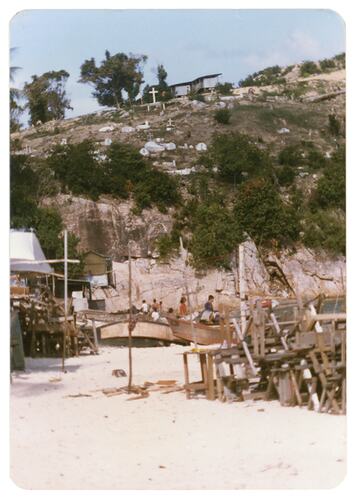Summary
Digital colour photograph of 'D' Beach showing two makeshift cafes used by Indo-Chinese refugees and staff and run by refugees. The stacked furniture suggests the cafe was closed when the photograph was taken and a refugee cemetery is visible on the cliff. It was taken at the refugee camp on the Malaysian island of Pulau Bidong off the coast of Terengganu in the South China Sea in April, 1981. The photographer was Lachlan Kennedy, who was a member of the Australian Department of Immigration Indo-Chinese Refugee Taskforce, from January-September 1981 during the aftermath of the Vietnam War. Refugees frequently worked at the camp as well as running their own small businesses on the island which they then onsold when they left.
Bidong was opened as a refugee camp in August 1978 and by June 1979 there were about 40,000 Indo-Chinese refugees on an island said to have capacity for about 4,500 people. From this time on the numbers declined with fewer arrivals and people processed and re-settled in countries such as Australia. Conditions on the island were crowded, with poor sanitation and housing, but the refugee population themselves were well organised, aid organisations were well-represented and representatives from re-settlement countries frequently visited. The refugee camp closed in 1991 with some 250,000 refugees having passed through and either re-settled or, eventually, forcibly repatriated.
Description of Content
Beach with stacked furniture, boats, a shanty building with cliff face in background. Cemetery visible on top of the cliff.
Physical Description
Colour digital photograph.
Significance
This important collection represents two sides of the asylum experience - the refugees and the government officials. These parallel and intersecting experiences have both personal and bureaucratic elements to them, linked by place, and world events, with craft and gifts of appreciation providing tangible points of connection and memory. The experiences of migration officials are frequently untold and unrepresented by material culture, as are material manifestations of refugee narratives. This collection enables the telling of both stories, with primacy given in this instance to the employee as custodian of the objects. The collection is also a symbol of a particular period in Australian migration history when support for refugee programs had both bipartisan and public support. Finally the theme of refugee, internee and detainee craft recurs across time and place and provides a tangible connection between very different human experiences, the trauma, economy and the tedium of which has been consistently alleviated through artistic practice.
More Information
-
Collecting Areas
Migration & Cultural Diversity, Transport, Images & Image Making
-
Acquisition Information
Donation from Mr Lachlan Kennedy, 16 Mar 2015
-
Photographer
Mr Lachlan Kennedy, Pulau Bidong, Terengganu, Malaysia, Apr 1981
-
Format
Digital file, Colour
-
Classification
Migration, Processing - immigration selection, Refugee camps
-
Category
-
Discipline
-
Type of item
-
Keywords
Vietnamese Immigration, Refugees, Water Transport, Water Vessel, Boats, Immigration, Immigrant Voyages, Immigration Selection, Vietnam War Refugees

